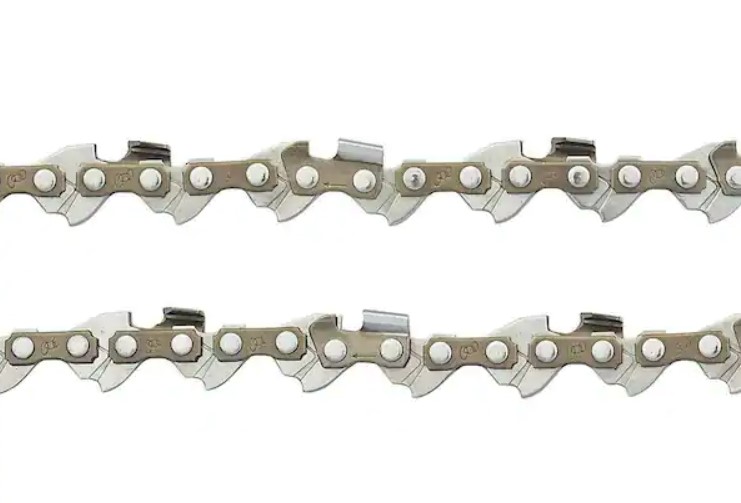Finding the Best Chainsaw Chain for Hardwood

Hardwood presents a formidable challenge to chainsaw users due to its dense composition and resilient cell structure. Varieties like oak, maple, hickory, and cherry boast robust fibers that demand specialized chains capable of handling their strength without wearing out.
4 Best Chainsaw Chains for Hardwood Mastery
1. Oregon S62 AdvanceCut Low Kickback Chain
Striking a balance between aggression and control, perfect for novice and experienced users dealing with hardwood.
2. Stihl 3610 005 Chainsaw Chain
A full-chisel powerhouse catering to professionals, providing unparalleled cutting speed and efficiency in hardwood cutting, albeit demanding frequent sharpening.
3. Forester Full-Chisel Chain Loop
Known for its durability and wear resistance, ideal for seasoned users tackling heavy-duty hardwood cutting.
4. Oregon S39 Semi-Chisel Chain Loop
A versatile option for users dealing with both hardwood and softwood, offering good cutting performance with extended sharpness.
Different Chainsaw Chains with their Features
Full Chisel Chains
- Aggressive Cutting: These chains feature square-edged teeth, delivering swift and efficient cutting by digging deep into hardwood. Ideal for seasoned professionals due to their ability to bite aggressively.
- Quick Wear and Kickback: However, their aggressive nature leads to rapid dulling, necessitating frequent sharpening, and poses a higher risk of kickback, requiring careful handling.
Semi Chisel Chains
- Balanced Performance: Sporting slightly rounded teeth, these chains offer a middle ground between aggression and durability. Effective for both hardwood and softwood cutting, appealing to homeowners and occasional users.
- Longer Sharpness, Lower Kickback: While not as swift as full chisel chains, they retain sharpness for extended periods and have lower kickback risks. Not the best for heavy-duty hardwood tasks though.
Micro Chisel Chains
- Precise and Delicate: Equipped with ultra-fine teeth, these chains ensure smoother cuts with minimal tear-out. Perfect for intricate carpentry and precision-based projects.
- Steady and Less Prone to Kickback: Despite being slower, their durability and low kickback make them ideal for beginners and those handling delicate hardwood projects.
Choosing the best chain for hardwood extends beyond just the teeth. Here are some additional factors to keep in mind:
- Chain Pitch: Common pitches for hardwood cutting include .325″ and .404″, with larger pitches offering enhanced durability for tougher tasks.
- Gauge: The thickness of drive links varies from standard (.063″) for most home tasks to heavier gauges (.080″) for professional users, ensuring better durability.
- Link Count: The number of links determines the chain’s length, crucial to match with the chainsaw’s bar length.
Frequently Asked Questions
Can I use a regular chain for cutting hardwood?
Technically possible, but using a chain designed for softwood on hardwood will result in slower cutting, increased wear, and a higher risk of kickback.
How often should I sharpen a chainsaw chain when cutting hardwood?
Hardwood dulls chains faster. Expect to sharpen a full chisel chain after every few cuts, while semi chisel chains might go a bit longer. Micro chisel chains typically require sharpening less frequently. Test the sharpness by running your finger along the teeth – if they feel blunt, it’s time to sharpen.
What’s the best way to sharpen a chainsaw chain?
You can hand-sharpen your chain with a file and jig or invest in a powered sharpener for faster, consistent results. Ensure you learn the proper angles and techniques for your specific chain type to avoid damaging the teeth.
Does chain oil matter for cutting hardwood?
Absolutely! Proper lubrication is crucial for any chainsaw task, especially hardwood cutting. Use high-quality, chainsaw-specific oil to reduce friction, prevent overheating, and ensure smooth cutting.
What safety precautions should I take when cutting hardwood?
Hardwood cutting demands extra caution. Always wear proper safety gear, including eye protection, hearing protection, gloves, and sturdy boots. Secure your footing, be aware of the log’s potential movement, and never force the chainsaw.
Are there alternatives to using a chainsaw for cutting hardwood?
For smaller logs or situations where a chainsaw isn’t ideal, consider using an axe or hatchet. However, this requires significant skill and physical strength, so proceed with caution if you’re inexperienced.
Conclusion
Selecting the right chain for hardwood is crucial for a safe and efficient cutting experience. By understanding different chain types, considering individual needs, and practicing proper sharpening and safety techniques, users can confidently handle even the toughest of trees. Conquer hardwood challenges with the right chain, and relish the satisfaction of a job well done.
Beyond the Chainsaw
This guide has primarily focused on chainsaw chains suited for hardwood. Remember, success also depends on factors like the chainsaw’s power, your skill level, and proper tool maintenance. Keep learning, hone your technique, and prioritize safety. With dedication and practice, you’ll master hardwood cutting like a pro!
Happy cutting!
